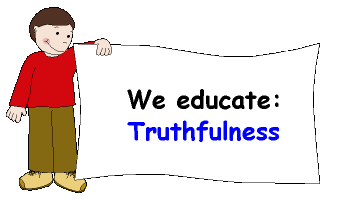|
We define truthfulness as a human quality. The truthful person is the one that always speaks, uses or professes the truth. It is a value that must be formed very early in children and as any value, it can be worked on in all their activities, either at school or at home. The Roman poet Horatio, referring to truthfulness, considered truthful what seems true according to the established standard by classic myths, which are the hierarchically expression of the social values. This statement of Horatio is valid regarding the fact that truthfulness is controlled by socially established norms and values, therefore, it is susceptible to education, and can be taught to our children. Although we propose pedagogical activities with this objective, it is necessary that the teacher knows that it is not enough; that he must use all the opportunities available in daily life in the early childhood center, to teach the children to be truthful and to know that the truth helps us to live in peace with other people. It is very interesting to encourage children to tell the truth in those situations that require it. We should be cautious of not confusing fantasy with the absence of truth and avoid the creation of situations that prevent the development of fantasy: that is a characteristic of the child’s mind. The work must start in those situations in which it is important to tell the truth. For this, the example of the adult plays a fundamental role. He should never lie to children, he should always give logical and real answers that favour the imitation and comprehension of the reason we must tell the truth. For example, if the educator asks what the children did during the weekend, the important thing is that they tell what was really done, although, the story takes a little fantasy, since for them, fantasy and the real thing interrelate and complement each other. Everything a child says is very important, it should be heard and the child should not be scolded when expressing his fantasies: the child is learning to express thoughts. There are situations that require the child to tell the truth, for example, when asked, who broke the toy? Or who won the competition? In these cases, we must be cautious when managing situations in which telling the truth may involve the disapproval of the adult. This value can be worked through conversations, stories, narrations, adaptations, puppet shows, etc. The results are achieved through patient and dedicated work, having always the care not to make demands above their possibilities. It must be remembered that some unimportant lies are normal in children behaviour, although, these should not be encouraged. To praise when children tell the truth is very useful, and parents should be orientated to keep a consistent attitude towards their children in this issue. |
ACTIVITY
No 1 |
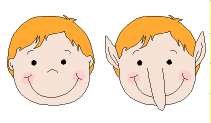 |
Summary of the activity: The teacher will demonstrate using descriptions and explanations of what truth is; what a truthful person looks like; and, the results that come from it. The teacher will develop a puppet show about a character that is a liar. Later, he will ask them to answer the questions asked by one of the puppets. Moreover, in another part of the activity, the children will create their own stories; they will tell anecdotes of known people or of characters that behave truthfully. Objectives: To develop some knowledge about truth in the child. Procedures:
Material Resources: A puppet stage, a toy television set and four puppets that can be made of gloves, or rods, etc., eyeglasses and a magnifying glass.
Development of the activity: The teacher will give examples of truthful people in the country or local history, also, people known by the children, that constitute true examples, who stood out for keeping a truthful attitude systematically. It will be explained to the children why we say they are truthful or practice the truth. Also, he will give examples of people or characters of stories that are liars (for example Pinocchio) and the damage they do to themselves and to others with their lies; that a lie generally harms our relationships with others, that it is very embarrassing to be called a liar, and also it is very hurtful to have our friends disbelieve us. He will emphasize that it is important to try telling the truth always and not only once, he will explain that it is necessary for living in peace, that people shouldn’t lie, that a lie hurts the establishment of good relationship among people. Later,
he will ask questions to verify if they have understood what was explained
to them, for example:
2nd Part Before the show, the teacher will guide the children on the content of the work, and ask them to observe the positive and negative behaviours of these characters regarding truth and lie. The show begins: “The Goblin on television” The puppet narrating the story appears and says: -Once upon a time, there was a goblin who had the misson of discovering lies, he watched from a corner of the house, where the television was; he was always vigilant. The goblin was told that there was a child named Thomas who told lies to his mother, and he decided to see what was happening in that house. (The puppet “Goblin on television” appears in the screen of a toy television set) Thomas appears and says; - What a fright! I believe that at any moment that goblin will look at me, directly to my eyes to tell me that he knows all the bad things I have done today. (Thomas in front of the television, looking at the television and moving as if he was afraid). The narrator says: But the goblin, inside the television, pretended he didn’t see Thomas looking at him, and kept cleaning up his glasses and a big magnifying glass. (The Goblin pretends he is cleaning his big glasses and a magnifying glass with a cloth). Thomas: - It is good that he is entertained! Now I will eat all the cookies in the kitchen and nobody will tell mom when she arrives at home. So, I will blame a bad mouse. Also, nobody will tell her about the broken dining room window, and I will act as if I didn't know. (Thomas goes to eat cookies, hiding himself in a corner) The narrator: - But, then, when he turned again his attention to the television, suddenly…. (The narrator points to the Goblin that is still in the television set). The Goblin, shouts, with a terrible reprehending voice:- Thomas, behave yourself or...! (the puppet appears showing his finger to Thomas ). The narrator:- Thomas could not believe it and got so scared that when his mom arrived, the first thing he did was…… (Points to Thomas’ mother). Thomas’ mother appears and says: Good afternoon, son, how have you been behaving today? Thomas: Mom, I have to tell you that I ate all the cookies and I broke the glass of the dining room window, I know that you… (Thomas with intermittent voice of sorrow and grief) The narrator:- He was expecting to be punished, but instead of that, it happened that…. (Points to Thomas’ mother ) Thomas’ mother: Son, you deserve a hug and a kiss. Not to congratulate you for the bad things you have done, because they aren’t right, but because I want to tell you that I am very happy of having a honest and courageous child, who dares to tell me the truth. You should do this always. (Thomas’ mother hugs and kisses him). Narrating puppet: - ...and from that day on, Thomas was much better. He doesn't do more bad things, he doesn't lie anymore to his mother and the Goblin of the television doesn’t have to appear in Thomas’ television set. 3rd
Part The teacher will wrap up the activity with a comment on the necessity of being truthful with everyone to keep friendly relationships that lead us to live in harmony with our family, neighbors, friends, etc. In addition, he will inform the children that the Goblin will be kept at school and he will be called “Goblin of the school”
4th Part The children must create the story by themselves, but if they can’t, the teacher can help them by asking questions. |
CRITERIAL
ASSESSMENT |
|||
Observed
conduct |
YES |
NO |
Comments |
They
gave a simple explanation about what truth is and what a truthful person
looks like. |
|||
They
gave examples of truthful people. |
|||
They
knew how to explain why it is necessary to tell the truth. |
|||
They
criticized liars. |
|||
They
made coherent statements on the importance of always telling the truth. |
|||
ACTIVITY
No 2 |
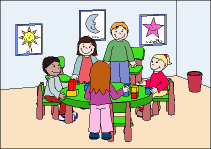 |
Summary of the activity: This is a role play about school. It could be played by any child that wants to and they will perform tasks they do at school, such as: to discuss a subject, to answer the teacher’s questions, to draw, etc. Objectives: Developing personal experience about truth in children. Procedures:
Material Resources: A place for the game with all material needed for this game, such as, tables, chairs, blackboard, books and notebooks, pencil holders, felt-tip pens, paper for drawings, color pencils, etc.
Development of the activity: The players will select on their own the material they will use, according to the chosen role.
2nd Part -Teacher, do you remember what we spoke about lies and truth? I believe that you as teacher should tell your group about what we have learned in previous activities on this subject. You can ask your children and they can answer what they think. They can also report on the truthful people or liars they know, family members or friends, or on characters of stories. The teacher, in his role as student can make some interventions, but he will let the children express themselves freely. He will only intervene if necessary. For example, if the game stops, if the children stray away from the argument, or to help solve conflicts, to keep and enrich this student-teacher conversation with his comments.
3rd Part
4th Part He will end by encouraging the students in the game that have carried out a good story about truthful people and liars. |
CRITERIAL
ASSESSMENT |
|||
Observed
conduct |
YES |
NO |
Comments |
They
knew how to act in the role they played, and to carry it out until the
end of the game. |
|||
They
made a coherent report on truthful people and liars. |
|||
They
were interested in making a good drawing for the selected person. |
|||
They
were touched when they described the person selected to receive the
drawing. |
|||
ACTIVITY
No 3 |
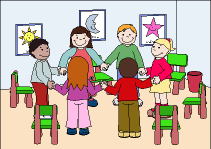 |
Summary of the activity: This activity consists of a motion game; the children will make a circle, when the music ceases they stop singing and run to reach a chair and sit down. Objectives:
Procedures: Material Resources: Chairs and a cassette recorder.
Development of the activity: The teacher will explain the rules of the game: The children will dance and sing in a circle, when the song stops, they will stop moving and will run towards a seat. There will always be a seat less than the number of children, therefore, one child will always remain standing. The rule of the game is: the child that ends up standing will be out of the game and the winner will be the child that manages to sit down.
2nd Part In the first lap: The music stops and they stop the movement and run towards the group of chairs, if there are 5 children there will be 4 seats, therefore, one remains standing and is out of the game. In the second lap: The music and the movement stops, they run towards the seats; now there will be only 3. In the third lap: The music and the movement stop, they run towards the 2 seats left. In the fourth lap: When the music and movement stop, they will run and just one child will be able to sit, he will be the winner.
3rd Part When the activity is completed, the teacher will ask for a strong applause for the winners; they will have to promise to the group to always tell the truth and to help their friends of the group to be truthful children. |
CRITERIAL
ASSESSMENT |
|||
Observed
conduct |
YES |
NO |
Comments |
They
were happy during the game. |
|||
They
followed the rules of the game. |
|||
ACTIVITY
No 4 |
Summary of the activity: This activity is a game in which the children will answer riddles given by the teacher, and will create their own. Objectives: Reinforce what they have learned about truth. Procedures:
Development
of the activity: The child that answers more riddles correctly and has created at least one riddle about the subject, with sense and coherence, will win. The child that knows the answer will raise his hand. The content of the riddles, the ones given by the teacher and the ones created by the children, will be about the related theme: the truth.
2nd Part
3rd Part |
CRITERIAL
ASSESSMENT |
|||
Observed
conduct |
YES |
NO |
Comments |
They
created simple riddles using the suggested subject. |
|||
They
demonstrated knowledge about what was learned when creating their
riddles. |
|||
ACTIVITY
No 5 |
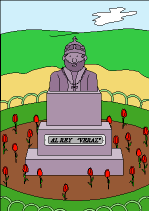 |
Summary of the activity: The teacher will organize a visit to a monument or statue of a community or country martyr or hero, near the school. They can also visit a dear and respected person in the community. We will search for those illustrious, outstanding and well known people in the country or in the community, who have been known, among their qualities, for having acted truthfully and contributed to peace in their country. Objectives: To develop personal experiences and feelings about truthful behavior, manifested by honorable or outstanding people in the community or country. Procedures: Material Resources: xxxxxxx
Development of the activity: If the visit is to a monument of a deceased person, the teacher will talk to the children about the values of this person.
2nd Part
3rd Part If the person comes to the classroom to talk to the children instead of the visit to a monument, it is necessary to create an environment of solemnity, respect and emotion, in order to touch the children’s feelings. The children will be given the opportunity to ask questions about what they want to know about this person. The activity will finish with the children giving their opinion on what they liked most, what impressed, touched them, etc., to know their evaluation of the activity and it will be emphasized how these people are models to be imitated by children and adults. 4th Part |
CRITERIAL
ASSESSMENT |
|||
Observed
conduct |
YES |
NO |
Comments |
They
were interested in learning about the person. |
|||
They
manifested touching expressions when listening to the story of the
life and facts of this person. |
|||
They
expressed their desire of being like the person. |
|||
They
behaved, at their level, with respect and solemnity during the activity. |
|||
ACTIVITY
No 6 |
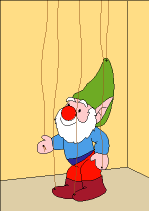 |
Summary of the activity: At the end of the week there will be an evaluation of what has happened in class during the week regarding truthful or untruthful behavior. For that, the goblin and the children will talk. Objectives: From the analysis of diverse situations occurred in the children’s center, and guided by the puppet, the children will evaluate the truthful or untruthful behavior of their peers and their own. Procedures:
Material Resources: The “Goblin of the school”.
Development of the activity: The teacher, who handles the puppet, must guide this evaluation in order to have their behavior, regarding truth and lie, analyzed with fairness and objectivity. The children will give their criteria and tell their experiences. The objective is to achieve a friendly evaluation; there will be recommendations for the ones that have not achieved it and praise for the ones who always told the truth. Negative comments will be avoided and if any child is evaluated or evaluates himself as a liar, just say: -Pedro has to work more to be able to tell always the truth, what can we recommend? So that everyone can have the opportunity of evaluating himself and others, this activity will be repeated many times in the course of the month or the trimester. It can be done, for example, at the end of each week, for a month. It will be what the teacher decides, it could be on a day of a chosen week after everyone has self-evaluated and they will be given another opportunity for self-evaluation and to be evaluated by those children that followed the advice from the group, for example: Pedro doesn’t always tell the truth, Jenny told a lie once, etc. In this activity the teacher will make sure that the evaluation is fair, and said in the appropriate way so that no child will feel bad, that recommendations are given and goals are set for those children that have lied, and above all we will avoid that any child is qualified directly as a liar in front of his peers. |
CRITERIAL
ASSESSMENT |
|||
Observed
conduct |
YES |
NO |
Comments |
They
self evaluated with fairness. |
|||
They
evaluated their peers with fairness. |
|||
They
focused the evaluation on what was asked: truthful and untruthful
behavior. |
|||
They
recognized and manifested in their evaluation the elements of a truthful
person or a liar. |
|||


